|
Background Material
Solar Flare # 2041509
NASA’s Reuven Ramaty High-Energy Solar Spectroscopic Imager (RHESSI) was launched on February 5th, 2002. It’s mission is to study solar flares. It is a space telescope that observes the highest energy forms of invisible light, X-rays and gamma rays. Images cannot be made in X-rays and gamma rays as easily as they are in visible light. For one thing, you can’t use mirrors to focus light into an image. X-rays and gamma rays pass right through mirrors. So the scientists and engineers that conceived and built RHESSI came up with a way to make images with mirrors. The images that are made are of emission of X-rays and sometimes gamma rays from the hottest places of a solar flare. Sometimes they look like nothing more than fuzzy blobs. So, scientists often use images from other satellites in space such as the SOHO or TRACE satellite to compare the images that they receive from RHESSI.
One of RHESSI’s main goals is to understand how magnetic fields on the Sun accelerate plasma in the Corona and cause solar flares. On April 15th, 2002, RHESSI observed a solar flare, officially designated at solar flare # 2041509. This flare was special for RHESSI scientists because it clearly illustrated that one model they had predicted for the cause of solar flares was very accurate. Scientists saw a coronal loop erupt and eject a blob of matter out into interplanetary space. Observations from the SOHO spacecraft following the RHESSI observations showed a CME erupting from the Sun in the same region where the solar flare had occurred. There are movies from observations of SOHO and TRACE of this solar flare available on the Exploring Magnetism website.
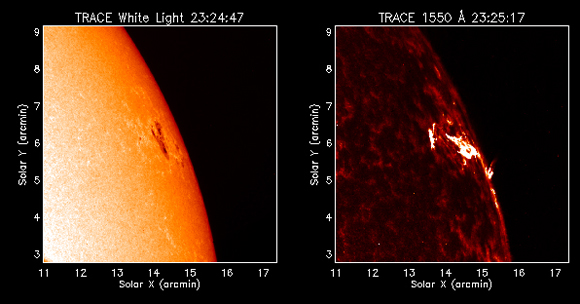
Figure BSF.1 These images of solar flare # 2041509 were taken by the TRACE spacecraft. The image on the left is in visible light. The sunspot group containing the footprints of the solar flare are visible in the image. The image on the right is of the same region of the Sun seen in ultraviolet light (which is invisible to the human eye, but not to TRACE).
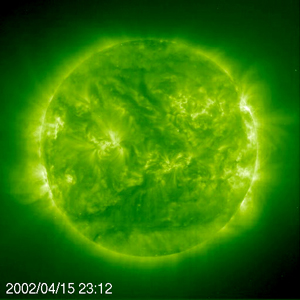
Figure BSF.2 This image is from the EIT instrument (Extreme ultraviolet Imaging Telescope) aboard the SOHO spacecraft. It was taken on April 15, 2002 at the time of solar flare # 2041509. Since ultraviolet light is invisible to the human eye, the color in the image is used to enhance features on the Sun. Here white-green color represents very bright ultraviolet light and dark-green/black indicates faint or no ultraviolet light. In the image we see hot gas trapped in magnetic fields in the Sun’s corona. The brightest spot in the upper right-hand quadrant of the Sun, near the edge, is the solar flare.
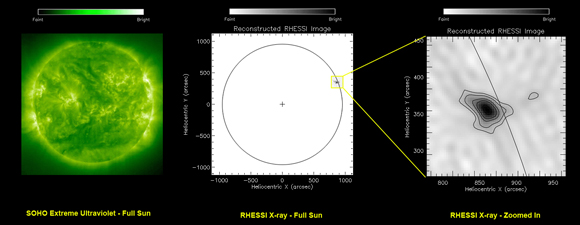
Figure BSF.3 Here we compare images of the Sun taken by SOHO and RHESSI. RHESSI views the Sun in even higher energy X-rays. The image in the center is like a photo-negative from RHESSI. The dark spots indicate bright X-rays and the white places indicate faint or no X-ray light. The image on the right is a zoomed in portion of the Sun where solar flare # 2041509 occurred. This image is like those used in Activity #3.
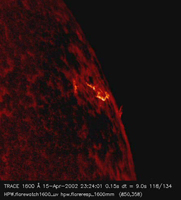 |
 |
Movie BSF.1
This movie was made from ultraviolet images taken by the TRACE spacecraft on April 15, 2002, the day of solar flare # 2041509. The movie is zoomed in on the solar flare and covers the last hour of the day, when the solar flare occurred. Hot plasma can be seen moving along magnetic field lines during the solar flare. |
Movie BSF.2
This movie was made from extreme ultraviolet images taken by the EIT instrument of the SOHO spacecraft on April 15, 2002, the day of solar flare # 2041509. The flare occurs at 23:12 (near the end of the day, and the movie) in the upper right-hand quadrant of the Sun. |
 |
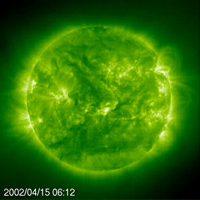 |
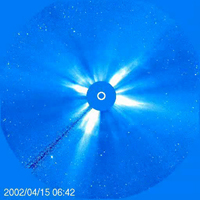 |
 |
Movie BSF.3
This movie is from visible light images made by the LASCO instrument aboard the SOHO spacecraft. The instrument holds out a disk in front of the camera to create an eclipse of the Sun. This makes the corona of the Sun visible. The white circle in the center of the disk represents the size of the Sun. Shortly after solar flare # 2041509 occurred in the lower corona near the end of the day on April 15, 2002, an expanding bubble of gas can be seen escaping the Sun in the first several hours of April 16th. This coronal mass ejection (CME) is above the location where the solar flare occurred (in the upper right quadrant). |
- back to top -
|
 |

